The Mechanical Behavior of Sustainable Concrete Using Raw and Processed Sugarcane Bagasse Ash
Abstract
:1. Introduction
2. Experimental Program
2.1. Materials
2.2. Mixture Proportions
2.3. Method of Casting and Curing
2.4. Test Methods
2.4.1. Compression Test
2.4.2. Young’s Modulus Test
2.4.3. Flexural Test
3. Results and Discussion
3.1. Unit Weight
3.2. Compressive Strength
3.3. Flexural Strength
3.4. Young’s Modulus
4. Discussion
4.1. Unit Weight
4.2. Compressive Strength
4.3. Flexural Strength
4.4. Young’s Modulus
5. Validation of Experimental Results Using ACI Predictions
5.1. Validation of Experimental Flexural Strength Results for SCBA-Blend Concrete
5.2. Validation of Experimental Young’s Modulus Results for SCBA Blended Concrete
6. Conclusions
- Despite the addition of sugarcane bagasse ash has proved to be beneficial in improving the studied mechanical properties of the concrete mix, such as compressive strength, flexure strength, and Young’s modulus, further processing is required to attain the intended results because using samples directly from the plant (raw SCBA) revealed that they were ineffective at improving the characteristics of the concrete mix.
- Raw SCBA concrete specimens had lower density, compressive strength, flexural strength, and Young’s modulus than processed SCBA concrete specimens at the same sugarcane bagasse ash proportion because raw SCBA has significantly larger particle sizes and lower silica content, resulting in much more porosity and voids in the concrete mixture and, ultimately, lower density and strength.
- Re-grinding for an hour, as well as re-burning raw sugarcane bagasse ash at 600 °C for two hours (processed SCBA), resulted in a significant improvement in the studied mechanical properties of the concrete mixture, with compressive strength, flexural strength, and Young’s modulus increasing up to 12%, 8%, and 8%, respectively, more than the normal concrete mixture. This is because the SCBA recycling process increased the amount of silica, which combines with calcium hydroxide to generate the calcium silica hydrate CSH matrix, which is primarily responsible for the strength of concrete.
- The optimal amount of processed SCBA to apply as a partial substitute for cement weight was 10%; however, adding more than this resulted in a deterioration in the concrete mixture’s density, compressive strength, flexural strength, and Young’s modulus. This is due to reducing the proportion of cement and thus the alumina content in the concrete mixture, which leads to the decay of the hydration of calcium aluminate and, as a result, reduces the strength.
- The flexural strength of sugarcane bagasse ash blended concrete specimens was measured experimentally and compared to ACI predictions. The comparison revealed that ACI underestimated the flexural strength of SCBA concrete specimens, with a mean coefficient of variation of 22% between the ACI equation and experimental results.
- Young’s modulus experimental results for raw and processed SCBA blended concrete specimens were slightly close and significantly consistent with ACI predictions; however, ACI overestimated Young’s modulus, with a mean coefficient of variance between the ACI equation and experimental results of −6%.
7. Future Studies
- Sugarcane bagasse ash blended concrete’s durability and mechanical characteristics subjected to different curing regimes;
- Sugarcane bagasse ash blended concrete’s durability and mechanical characteristics subjected to different calcination temperatures;
- Effect of different recycling processes of sugarcane bagasse ash on the mechanical properties of the concrete mixture;
- Mechanical behavior of hybrid fly ash-sugarcane bagasse ash blended concrete.
Author Contributions
Funding
Data Availability Statement
Conflicts of Interest
References
- Juenger, M.C.G.; Snellings, R.; Bernal, S.A. Supplementary cementitious materials: New sources, characterization, and performance insights. Cem. Concr. Res. 2019, 122, 257–273. [Google Scholar] [CrossRef]
- Naqi, A.; Jang, J.G. Recent progress in green cement technology utilizing low carbon emission fuels and raw materials: A Review. Sustainability 2019, 11, 537. [Google Scholar] [CrossRef]
- Moussa, R.; Micheal, A. Evaluating the Effect of Adding Sugarcane Bagasse to the Fire Clay Brick’s Properties. In Architectural Engineering; BUE University: El Sherouk, Egypt, 2022; Volume 10. [Google Scholar]
- Ganesan, K.; Rajagopal, M.; Thangavel, K. Evaluation of bagasse ash as supplementary cementitious material. Cem. Concr. Compos. 2007, 29, 515–524. [Google Scholar] [CrossRef]
- Nuntachai, C.; Chai, J.; Kraiwood, K. Utilization of bagasse ash as a pozzolanic material in concrete. Constr. Build. Mater. 2009, 23, 3352–3358. [Google Scholar]
- Murugesan, T.; Vidjeapriya, R.; Bahurudeen, A. Sugarcane bagasse ash-blended concrete for effective resource utilization between sugar and construction industries. Sugar Tech. 2020, 22, 858–869. [Google Scholar] [CrossRef]
- Frias, M.; Villar, E.; Savastano, H. Brazilian sugar cane bagasse ashes from the cogeneration industry as active pozzolans for cement manufacture. Cem. Concr. Compos. 2011, 33, 490–496. [Google Scholar] [CrossRef]
- Sande, V.; Sadique, M.; Pineda, P.; Bras, A.; Atherton, W.; Riley, M. Potential use of sugar cane bagasse ash as sand replacement for durable concrete. J. Build. Eng. 2021, 39, 102277. [Google Scholar] [CrossRef]
- Miller, S.A.; Horvath, A.; Monteiro, P.J.M. Readily implementable techniques can cut annual CO2 emissions from the production of concrete by over 20%. Environ. Res. Lett. 2016, 11, 074029. [Google Scholar] [CrossRef]
- Agwa, I.; Zeyad, M.; Tayeh, A.; Adesina, A.; RG de Azevedo Amin, M.; Hadzima-Nyarko, M. A comprehensive review on the use of sugarcane bagasse ash as a supplementary cementitious material to produce eco-friendly concretes. Mater. Today Proc. 2022, 65, 688–696, ISSN 2214-7853. [Google Scholar] [CrossRef]
- Heede, R. Tracing anthropogenic carbon di oxide and methane emissions to fossil fuel and cement producers 1854–2010. Clim. Change 2014, 122, 229–241. [Google Scholar] [CrossRef]
- Jagadesh, P.; Ramachandramurthy, A.; Murugesan, R. Effect of water cementitious ratio on the strength development of Unary Blended Concrete—An overview. Int. J. Earth Sci. Eng. 2015, 8, 1493–1500. [Google Scholar]
- Cordeiro, G.C.; Toledo Filho, R.D.; Tavarse, L.M.; Fairbairn, E.M.; Hempel, S. Influence of particle size and specific surface area on the pozzolanic activity of residual rice husk ash. Cem. Concr. Compos. 2011, 33, 529–534. [Google Scholar] [CrossRef]
- Santos, T.A.; Neto, J.S.d.; Santos, V.S.; Ribeiro, D.V. Influence of physicochemical properties of sugarcane bagasse ash (SCBA) in Portland cement hydration. In Key Engineering Materials; Trans Tech Publications Ltd.: Bäch, Switzerland, 2018; pp. 324–328. [Google Scholar] [CrossRef]
- Cordeiro, G.C.; Filho, R.D.; Tavares, L.M.; Fairbairn, E.M. Ultrafine grinding of sugar cane bagasse ash for application as pozzolanic admixture in concrete. Cem. Concr. Res. 2009, 39, 110–115. [Google Scholar] [CrossRef]
- Cordeiro, G.C.; Toledo Filho, R.D.; Fairbairn, E.M. Effect of calcination temperature on the pozzolanic activity of sugar cane bagasse ash. Constr. Build. Mater. 2009, 23, 3301–3303. [Google Scholar] [CrossRef]
- Ribeiro, D.V.; Morelli, M.R. Effect of calcination temperature on the pozzolanic activity of Brazilian sugar cane bagasse ash (SCBA). Mater. Res. 2014, 17, 974–981. [Google Scholar] [CrossRef]
- Kumar, D.S.S.; Chethan, K.; Kumar, B.C. Effect of Elevated Temperatures on Sugarcane Bagasse Ash-Based Alkali-Activated Slag Concrete. Sugar Tech 2021, 23, 369–381. [Google Scholar] [CrossRef]
- Agwa, I.; Zeyad, A.; Tayeh, B.; Sherif, M. Effect of different burning degrees of sugarcane leaf ash on the properties of ultrahigh-strength concrete. J. Build. Eng. 2022, 56, 104773. [Google Scholar] [CrossRef]
- Bahurudeen, A.; Kanraj, D.; Dev, V.G.; Santhanam, A.M. Performance evaluation of sugarcane bagasse ash blended cement in concrete. Cem. Concr. Compos. 2015, 59, 77–88. [Google Scholar] [CrossRef]
- Quedoua, P.G.; Wirquinb, E.; Bokhoreec, C. Sustainable concrete: Potency of sugarcane bagasse ash as a cementitious material in the construction industry. Case Stud. Constr. Mater. 2021, 14, e00545. [Google Scholar] [CrossRef]
- Jagadesh, P.; Ramachandramurthy, A.; Murugesan, R. Evaluation of mechanical properties of Sugar Cane Bagasse Ash concrete. Constr. Build. Mater. 2018, 176, 608–617. [Google Scholar] [CrossRef]
- Jagadesh, P.; Murthy, A.R.; Murugesan, R. Effect of processed sugar cane bagasse ash on mechanical and fracture properties of blended mortar. Constr. Build. Mater. 2020, 262, 120846. [Google Scholar] [CrossRef]
- Neto, J.; de França, M.S.; Júnior, N.; Ribeiro, D. Effects of adding sugarcane bagasse ash on the properties and durability of concrete. Constr. Build. Mater. 2021, 266, 120959. [Google Scholar] [CrossRef]
- Loganayagan, S.; Mohan, N.C.; Dhivyabharathi, S. Sugarcane bagasse ash as alternate supplementary cementitious material in concrete. Mater. Today Proc. 2021, 45, 1004–1007. [Google Scholar] [CrossRef]
- Bayapureddy, Y.; Muniraj, K.; Mutukuru, M.R.G. Sugarcane bagasse ash as supplementary cementitious material in cement composites: Strength, durability, and microstructural analysis. J. Korean Ceram. Soc. 2020, 57, 513–519. [Google Scholar] [CrossRef]
- Hussien, N.T.; Oan, A.F. The use of sugarcane wastes in concrete. J. Eng. Appl. Sci. 2022, 69, 31. [Google Scholar] [CrossRef]
- Srinivasan, R.; Sathiya, K. Experimental study on bagasse ash in concrete. Int. J. Serv. Learn. Eng. Humanit. Eng. Soc. Entrep. 2010, 5, 60–66. [Google Scholar] [CrossRef]
- Kiran, K.; Kishore, I.S. An experimental study on partial replacement of cement with bagasse ash in concrete mix. Int. J. Civ. Eng. Technol. 2017, 8, 452–455. [Google Scholar]
- Priya, K.L.; Ragupathy, R. Effect of sugarcane bagasse ash on strength properties of concrete. Int. J. Res. Eng. Technol. 2016, 5, 159–164. [Google Scholar]
- Borrero, E.L.; Farhangi, V.; Jadidi, K.; Karakouzian, M. An Experimental Study on Concrete’s Durability and Mechanical Characteristics Subjected to Different Curing Regimes. Civ. Eng. J. 2021, 7, 676–689. [Google Scholar] [CrossRef]
- Roshani, M.M.; Kargar, S.H.; Farhangi, V.; Karakouzian, M. Predicting the Effect of Fly Ash on Concrete’s Mechanical Properties by ANN. Sustainability 2021, 13, 1469. [Google Scholar] [CrossRef]
- Chuewangkam, N.; Nachaithong, T.; Chanlek, N.; Thongbai, P.; Pinitsoontorn, S. Mechanical and Dielectric Properties of Fly Ash Geopolymer/Sugarcane Bagasse Ash Composites. Polymers 2022, 14, 1140. [Google Scholar] [CrossRef]
- Le, D.-H.; Sheen, Y.-N.; Lam, M.-T. Fresh and hardened properties of self compacting concrete with sugarcane bagasse ash–slag blended cement. Constr. Build. Mater. 2018, 185, 138–147. [Google Scholar] [CrossRef]
- Rajasekar, A.; Arunachalam, K.; Kottaisamy, M.; Saraswathy, V. Durability characteristics of Ultra High Strength Concrete with treated sugarcane bagasse ash. Construct. Build. Mater. 2018, 171, 350–356. [Google Scholar] [CrossRef]
- Kumar, S.P.; Sankarsubramaniam, G.; Sindhu, S. Strength, permeability and microstructure characterization of pulverized bagasse ash in cement mortars. Constr. Build. Mater. 2020, 238, 117691. [Google Scholar] [CrossRef]
- Yu, J.; Zhang, M.; Li, G.; Meng, J.; Leung, C.K.Y. Using nano silica to improve mechanical and fracture properties of fiber reinforced high volume fly ash cement mortar. Constr. Build. Mater. 2020, 239, 117853. [Google Scholar] [CrossRef]
- Wu, K.; Long, J.; Xu, L.; de Schutter, G. A study on the chloride diffusion behavior of blended cement concrete in relation to aggregate and ITZ. Constr. Build. Mater. 2019, 223, 1063–1073. [Google Scholar] [CrossRef]
- Shafiq, N. Compressive strength and microstructure of sugar cane bagasse ash concrete. Res. J. App. Eng. Res. 2014, 7, 2569–2577. [Google Scholar]
- Vasudha, D.; Katare, M.; Madurwar, V. Experimental characterization of sugarcane biomass ash—A review. Construct. Build. Mater. 2017, 152, 1–15. [Google Scholar] [CrossRef]
- Akash, G.S.; Chetan, T.; Magnur, D.S.; Shivakumara, B. Experimental study on partial replacement of sand with sugarcane bagasse ash in concrete. Int. Res. J. Eng. Tech. 2018, 5, 3582–3584. [Google Scholar]
- Joshaghani, A.; Moeini, M.A. Evaluating the effects of sugarcane-bagasse ash and rice-husk ash on the mechanical and durability properties of mortar. Am. Soc. Civ. Eng. 2018, 30, 4401–4414. [Google Scholar] [CrossRef]
- Maldonado-García, M.A.; Hern’andez-Toledo, U.I.; Montes-García, P.; Valdez-Tamez, P.L. The influence of untreated sugarcane bagasse ash on the microstructural and mechanical properties of mortars. Mater. Constr. 2018, 68, e148. [Google Scholar] [CrossRef] [Green Version]
- ACI 318-19; Building Code Requirements for Structural Concrete and Commentary. American Concrete Institute: Farmington Hills, MI, USA, 2019.
- ECP 203-18; Egyptian Code for Design and Construction of Concrete Buildings. National Center for Research: Cairo, Egypt, 2018.

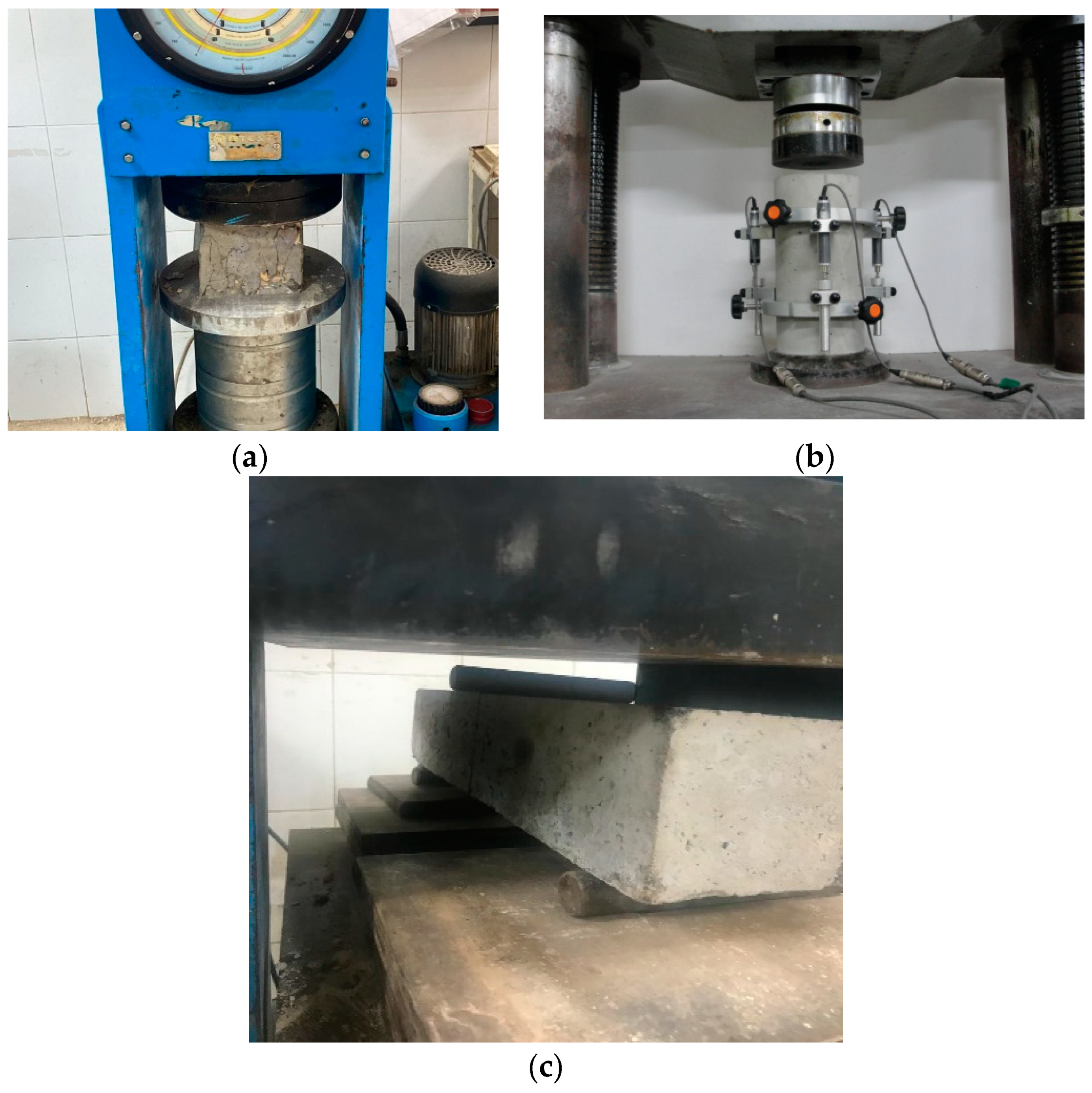
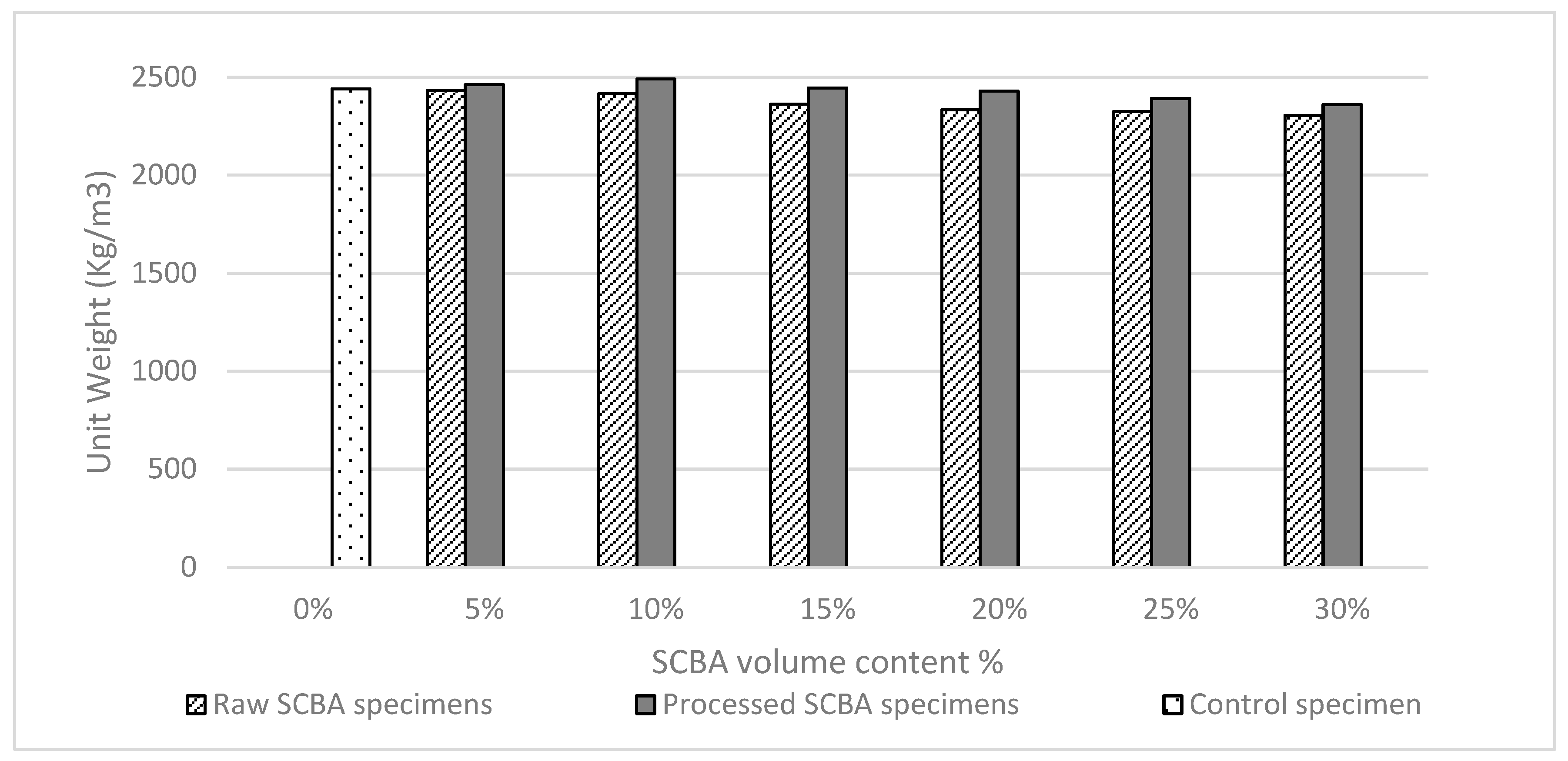
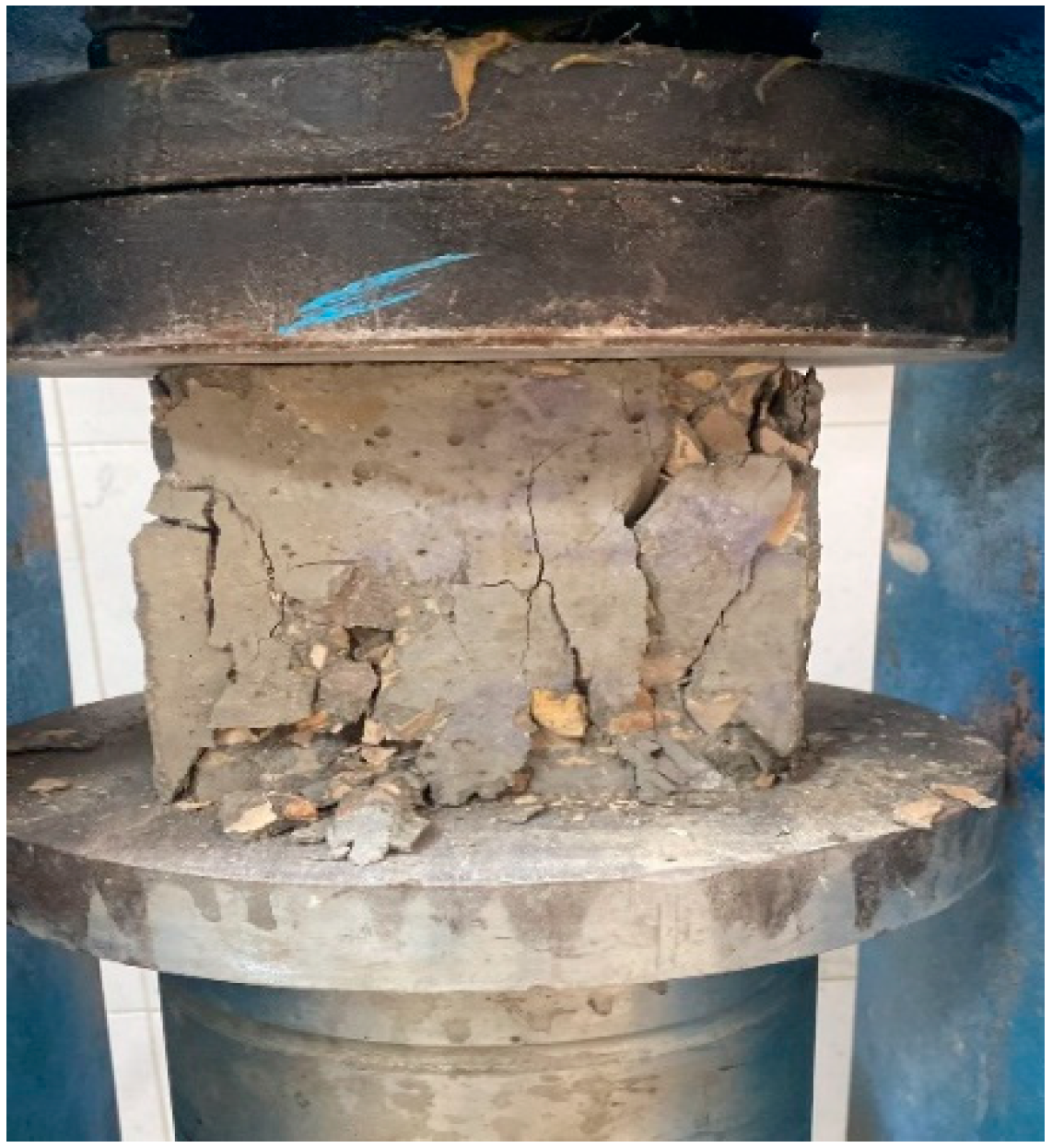
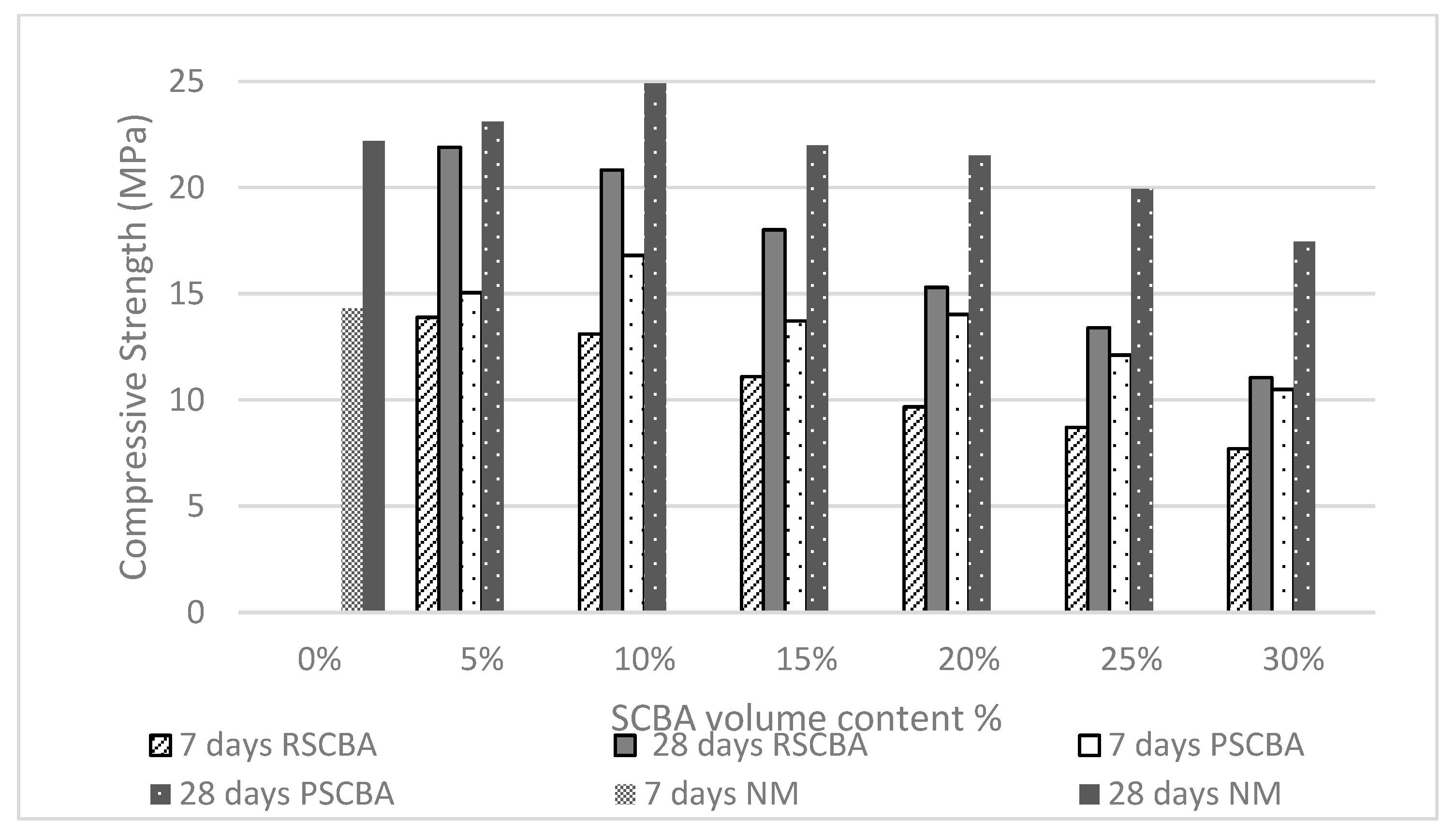
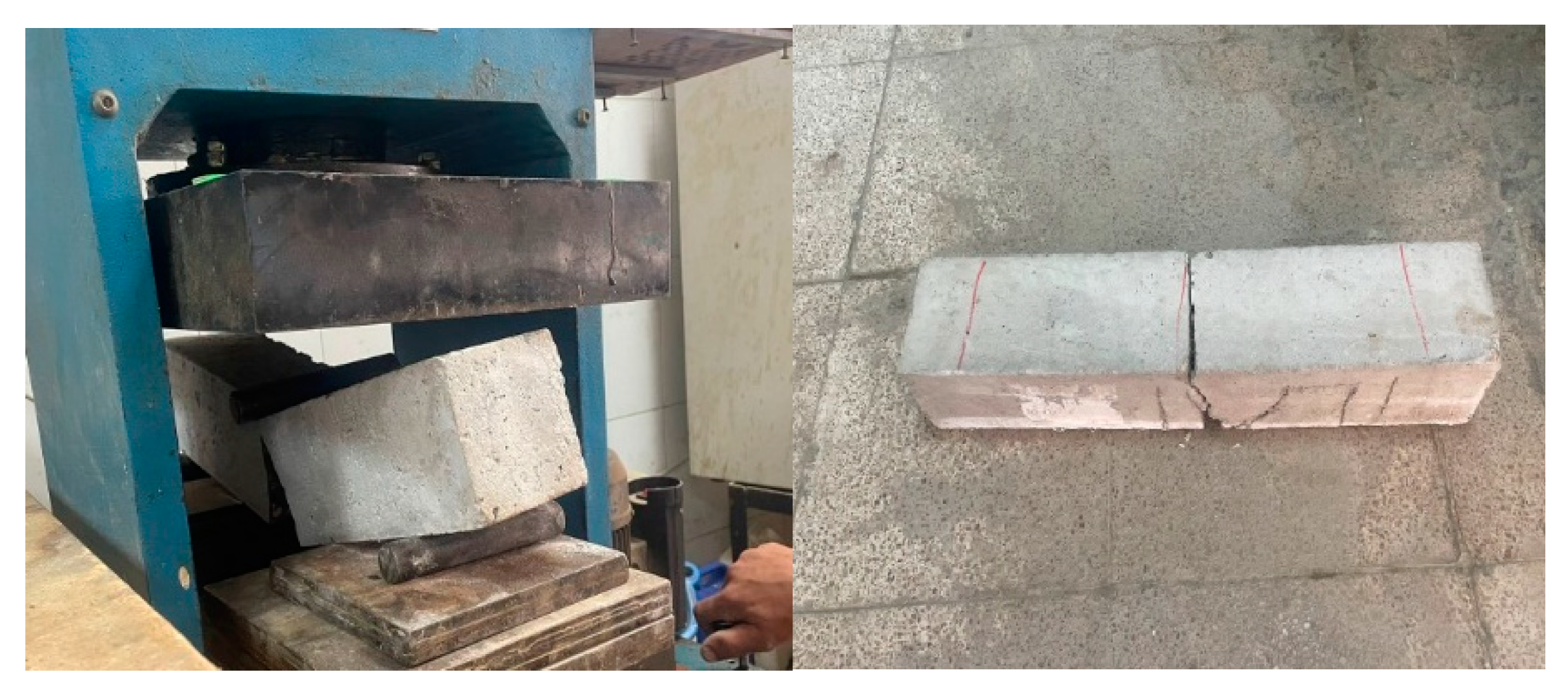
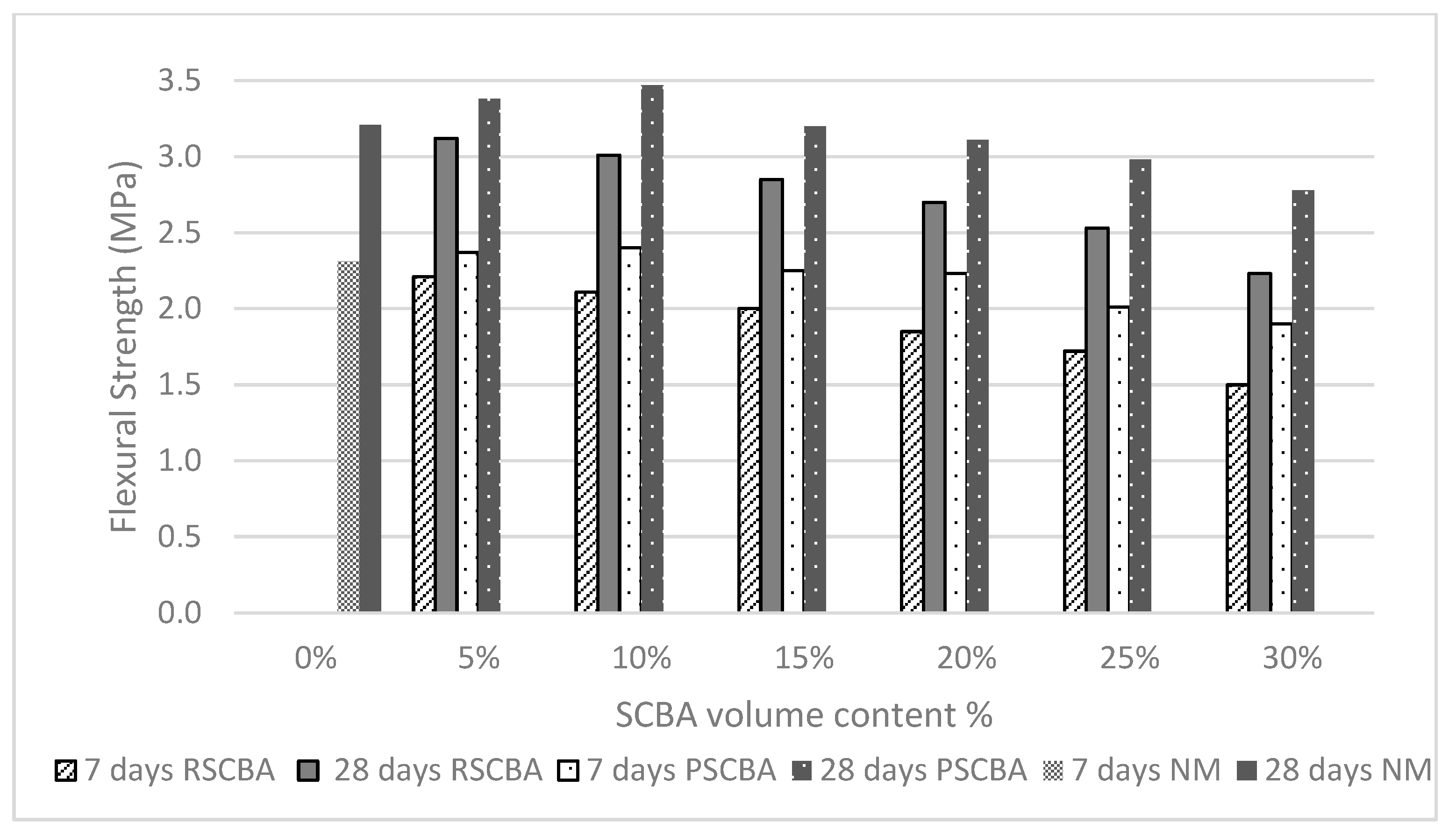
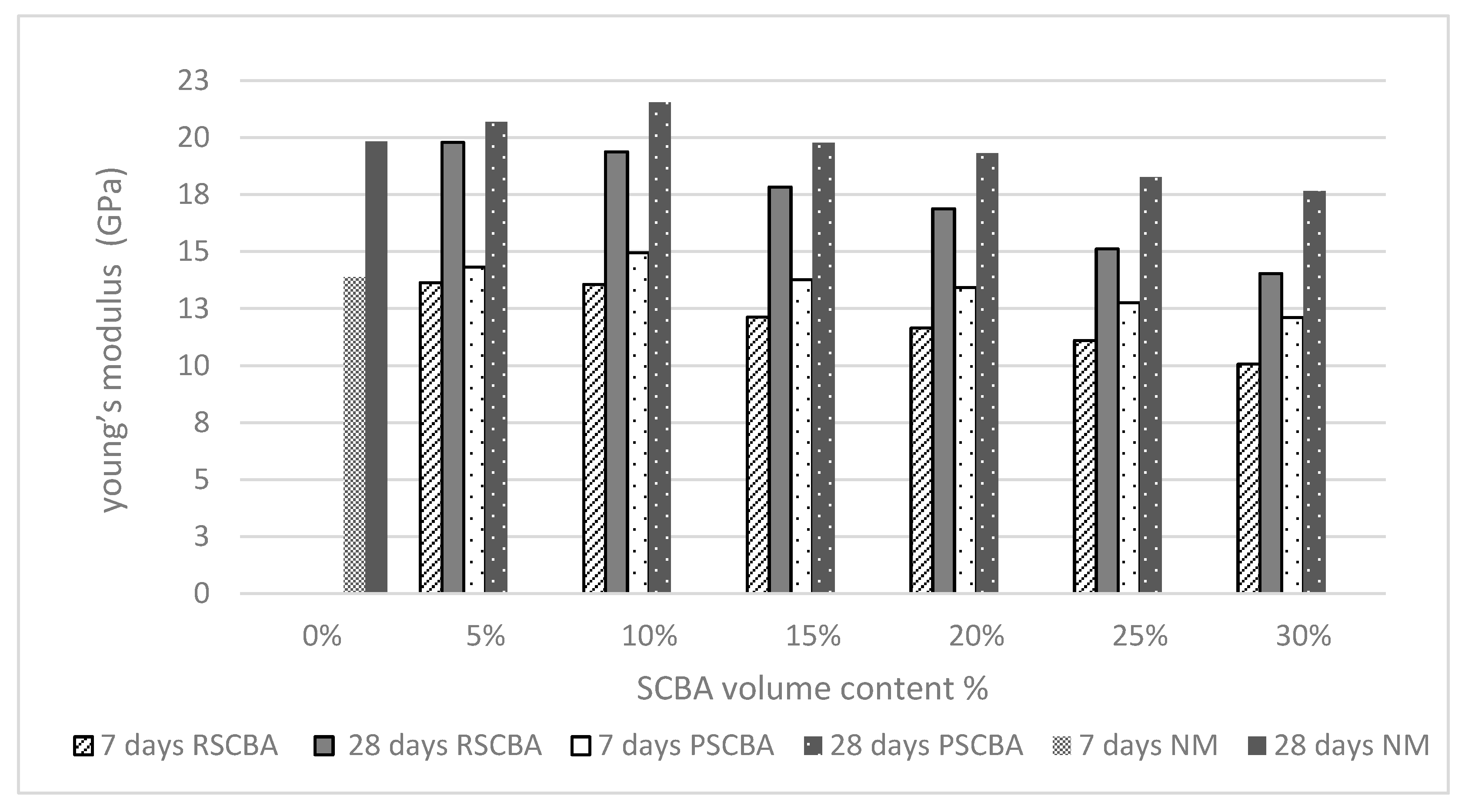
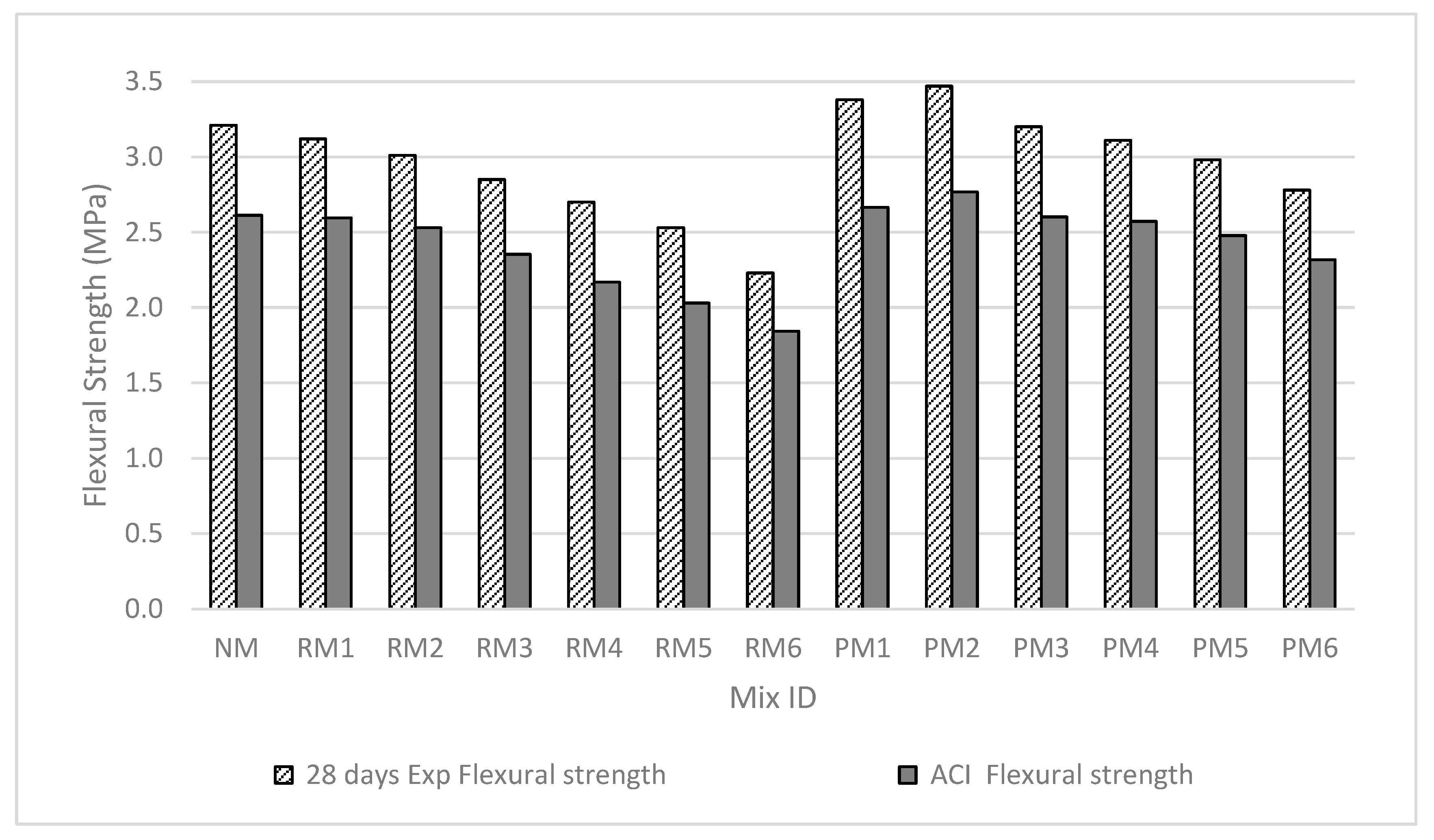
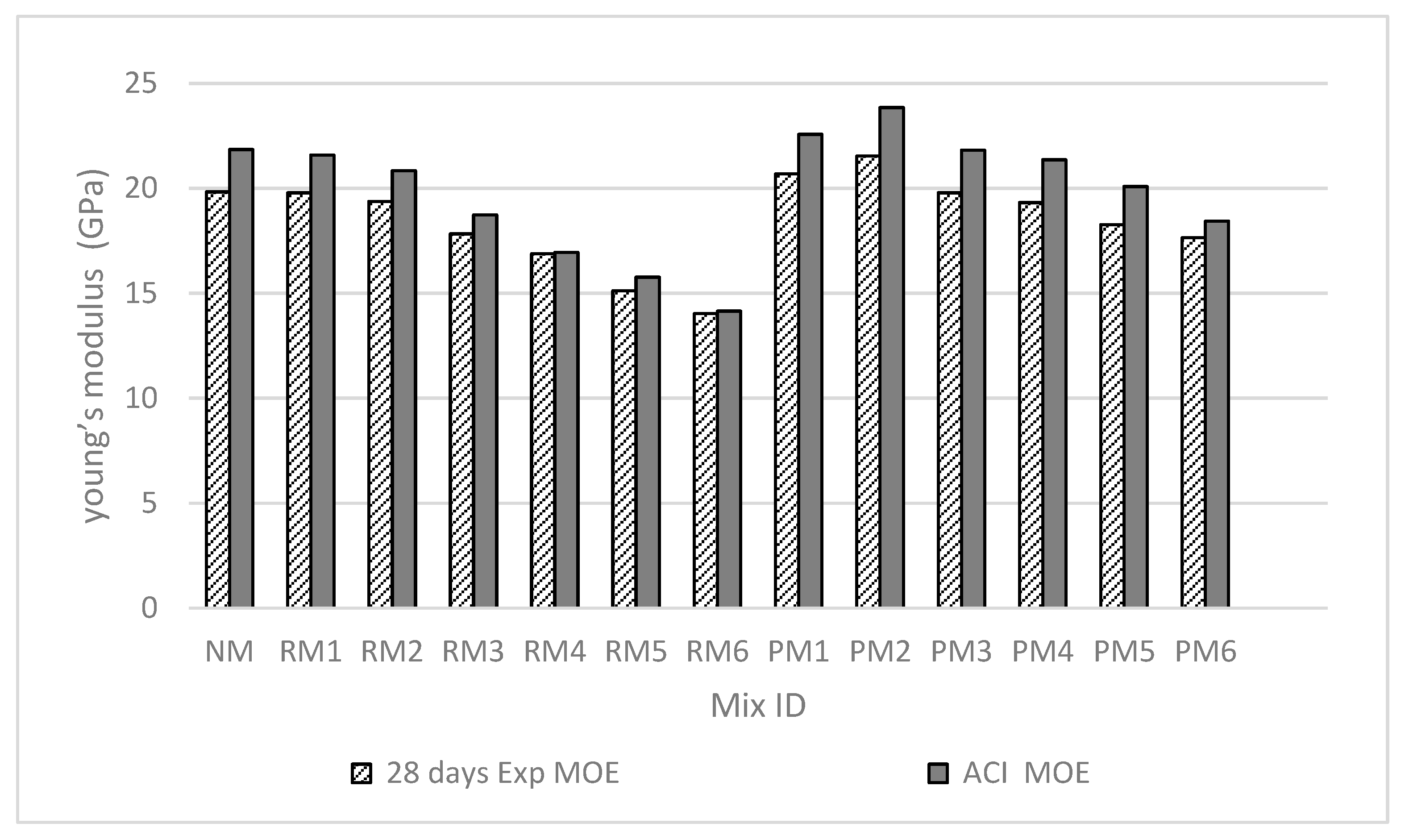
| Properties | Specific Gravity | Retained on Sieve 75 µm (%) | Bulk Density (kg/m3) | Average Particle Size (µm) |
|---|---|---|---|---|
| OPC | 3.15 | - | 1440 | 25 |
| RSCBA | 1.91 | 30 | 1410 | 75 |
| PSCBA | 2.23 | 9.5 | 1480 | 40 |
| Properties | SiO2 | Al2O3 | Fe2O3 | Cao | Na2O | K2O | MgO |
|---|---|---|---|---|---|---|---|
| OPC | 22.14 | 5.50 | 2.83 | 63.50 | - | 0.4 | 3.2 |
| RSCBA | 50.80 | 3.40 | 0.40 | 4.91 | 0.90 | 4.10 | 5.03 |
| PSCBA | 63.10 | 4.65 | 4.01 | 3.90 | 0.43 | 3.82 | 2.90 |
| Properties | Specific Gravity | Water Absorption (%) | Moisture Content (%) | |
|---|---|---|---|---|
| Fine Aggregate | 2.732 | 2.41 | 1.72 | |
| Coarse Aggregate | 20 mm | 2.751 | 0.51 | 0.31 |
| 10 mm | 2.742 | 0.75 | 0.36 | |
| KERRYPNX | MIX ID | OPC (kg/m3) | RSCBA % | PSCBA % | Coarse Aggregate (kg/m3) | Fine Aggregate (kg/m3) | W/C Ratio | ||
|---|---|---|---|---|---|---|---|---|---|
| 20 mm | 10 mm | ||||||||
| NM | 360 | - | - | 800 | 350 | 715 | 0.5 | ||
| Group 1 | RSCBA | RM1 | 342 | 5 | - | 800 | 350 | 715 | 0.5 |
| RM2 | 324 | 10 | - | 800 | 350 | 715 | 0.5 | ||
| RM3 | 306 | 15 | - | 800 | 350 | 715 | 0.5 | ||
| RM4 | 288 | 20 | - | 800 | 350 | 715 | 0.5 | ||
| RM5 | 270 | 25 | - | 800 | 350 | 715 | 0.5 | ||
| RM6 | 252 | 30 | - | 800 | 350 | 715 | 0.5 | ||
| Group 2 | PSCBA | PM1 | 342 | - | 5 | 800 | 350 | 715 | 0.5 |
| PM2 | 324 | - | 10 | 800 | 350 | 715 | 0.5 | ||
| PM3 | 306 | - | 15 | 800 | 350 | 715 | 0.5 | ||
| PM4 | 288 | - | 20 | 800 | 350 | 715 | 0.5 | ||
| PM5 | 270 | - | 25 | 800 | 350 | 715 | 0.5 | ||
| PM6 | 252 | - | 30 | 800 | 350 | 715 | 0.5 | ||
| MIX ID | Compressive Strength (MPa) 7 Days | Flexural Strength (MPa) 7 Days | Young’s Modulus (GPa) 7 Days | ||||||
|---|---|---|---|---|---|---|---|---|---|
| Average | Max Coeff of Variance % | Average | Max Coeff of Variance % | Average | Max Coeff of Variance % | ||||
| NM | 14.44 | 14.31 | 1.96 | 2.30 | 2.31 | 3.46 | 13.50 | 13.88 | 3.54 |
| 13.90 | 2.24 | 13.77 | |||||||
| 14.59 | 2.39 | 14.37 | |||||||
| RM1 | 14.20 | 13.89 | 2.23 | 2.11 | 2.21 | 2.71 | 13.70 | 13.64 | 1.99 |
| 13.84 | 2.25 | 13.31 | |||||||
| 13.63 | 2.27 | 13.91 | |||||||
| RM2 | 14.00 | 13.10 | 7.02 | 2.00 | 2.11 | 4.27 | 13.40 | 13.56 | 4.57 |
| 14.02 | 2.20 | 13.10 | |||||||
| 11.28 | 2.13 | 14.18 | |||||||
| RM3 | 10.80 | 11.10 | 1.44 | 2.00 | 2.00 | 5.50 | 12.50 | 12.13 | 3.08 |
| 11.24 | 2.11 | 12.00 | |||||||
| 11.26 | 1.89 | 11.88 | |||||||
| RM4 | 9.01 | 9.68 | 8.26 | 1.80 | 1.85 | 2.70 | 11.00 | 11.64 | 6.66 |
| 9.55 | 1.85 | 11.51 | |||||||
| 10.48 | 1.90 | 12.42 | |||||||
| RM5 | 8.60 | 8.71 | 3.56 | 1.80 | 1.72 | 4.65 | 11.19 | 11.10 | 0.81 |
| 9.02 | 1.71 | 11.00 | |||||||
| 8.51 | 1.65 | 11.11 | |||||||
| RM6 | 7.90 | 7.70 | 3.90 | 1.45 | 1.50 | 6.67 | 10.45 | 10.07 | 3.83 |
| 8.00 | 1.60 | 10.31 | |||||||
| 7.20 | 1.45 | 9.44 | |||||||
| PM1 | 14.21 | 15.05 | 4.58 | 2.35 | 2.37 | 1.27 | 13.55 | 14.32 | 3.53 |
| 15.20 | 2.40 | 14.82 | |||||||
| 15.74 | 2.36 | 14.58 | |||||||
| PM2 | 16.00 | 16.80 | 8.87 | 2.35 | 2.40 | 7.92 | 14.30 | 14.94 | 3.99 |
| 16.11 | 2.26 | 14.99 | |||||||
| 18.29 | 2.59 | 15.54 | |||||||
| PM3 | 13.66 | 13.72 | 2.04 | 2.20 | 2.25 | 2.22 | 13.00 | 13.76 | 5.23 |
| 14.00 | 2.30 | 13.80 | |||||||
| 13.50 | 2.25 | 14.48 | |||||||
| PM4 | 14.00 | 14.02 | 2.14 | 2.19 | 2.23 | 7.62 | 13.20 | 13.42 | 1.39 |
| 14.32 | 2.10 | 13.61 | |||||||
| 13.74 | 2.40 | 13.46 | |||||||
| PM5 | 12.30 | 12.11 | 1.57 | 2.00 | 2.01 | 6.97 | 12.45 | 12.75 | 2.81 |
| 12.10 | 2.15 | 12.70 | |||||||
| 11.93 | 1.88 | 13.11 | |||||||
| PM6 | 10.05 | 10.50 | 7.14 | 1.80 | 1.90 | 4.74 | 12.00 | 12.11 | 0.97 |
| 10.20 | 1.91 | 12.10 | |||||||
| 11.25 | 1.99 | 12.23 | |||||||
| MIX ID | Density (kg/m3) 28 Days | Compressive Strength (MPa) 28 Days | Flexural Strength (MPa) 28 Days | Young’s Modulus (GPa) 28 Days | ||||||||
|---|---|---|---|---|---|---|---|---|---|---|---|---|
| Average | Max Coeff of Variance % | Average | Max Coeff of Variance % | Average | Max Coeff of Variance % | Average | Max Coeff of Variance % | |||||
| NM | 2570 | 2440 | 5.33 | 23.20 | 22.20 | 4.50 | 3.32 | 3.21 | 3.43 | 19.80 | 19.83 | 1.41 |
| 2400 | 21.30 | 3.20 | 20.11 | |||||||||
| 2350 | 22.10 | 3.11 | 19.58 | |||||||||
| RM1 | 2390 | 2431 | 7.08 | 22.00 | 21.90 | 4.11 | 3.00 | 3.12 | 3.21 | 19.50 | 19.79 | 2.75 |
| 2300 | 20.90 | 3.22 | 20.33 | |||||||||
| 2603 | 22.80 | 3.14 | 19.53 | |||||||||
| RM2 | 2350 | 2415 | 3.52 | 20.00 | 20.82 | 4.71 | 2.80 | 3.01 | 4.65 | 20.00 | 19.37 | 3.81 |
| 2500 | 21.80 | 3.15 | 20.11 | |||||||||
| 2395 | 20.66 | 3.08 | 18.00 | |||||||||
| RM3 | 2390 | 2361 | 1.23 | 18.40 | 18.01 | 2.17 | 2.91 | 2.85 | 2.11 | 17.99 | 17.83 | 0.94 |
| 2320 | 17.50 | 2.90 | 18.00 | |||||||||
| 2373 | 18.13 | 2.74 | 17.51 | |||||||||
| RM4 | 2390 | 2332 | 3.17 | 15.67 | 15.30 | 4.77 | 2.59 | 2.70 | 2.22 | 17.00 | 16.88 | 3.29 |
| 2200 | 14.20 | 2.75 | 16.21 | |||||||||
| 2406 | 16.03 | 2.76 | 17.44 | |||||||||
| RM5 | 2450 | 2323 | 5.47 | 13.90 | 13.40 | 3.73 | 2.68 | 2.53 | 5.93 | 15.06 | 15.12 | 3.20 |
| 2167 | 12.50 | 2.40 | 15.60 | |||||||||
| 2352 | 13.80 | 2.51 | 14.69 | |||||||||
| RM6 | 2233.1 | 2304 | 2.00 | 10.71 | 11.05 | 2.62 | 2.30 | 2.23 | 3.14 | 15.06 | 14.04 | 7.29 |
| 2350 | 11.10 | 2.20 | 14.51 | |||||||||
| 2329 | 11.34 | 2.19 | 12.54 | |||||||||
| PM1 | 2409 | 2461 | 1.58 | 24.05 | 23.10 | 4.11 | 3.25 | 3.38 | 6.21 | 19.00 | 20.69 | 8.92 |
| 2500 | 23.00 | 3.30 | 20.53 | |||||||||
| 2474 | 22.25 | 3.59 | 22.53 | |||||||||
| PM2 | 2322 | 2490 | 8.35 | 23.22 | 24.90 | 6.71 | 3.38 | 3.47 | 1.73 | 21.50 | 21.54 | 2.93 |
| 2450 | 24.91 | 3.50 | 20.95 | |||||||||
| 2698 | 26.57 | 3.53 | 22.17 | |||||||||
| PM3 | 2590 | 2439 | 6.19 | 23.90 | 22.00 | 8.64 | 3.30 | 3.20 | 3.12 | 19.33 | 19.78 | 1.62 |
| 2338.1 | 21.09 | 3.25 | 20.10 | |||||||||
| 2389 | 21.01 | 3.05 | 19.91 | |||||||||
| PM4 | 2380 | 2429 | 4.39 | 20.90 | 21.51 | 5.21 | 3.26 | 3.11 | 4.82 | 18.56 | 19.32 | 3.01 |
| 2371.4 | 21.00 | 3.07 | 19.90 | |||||||||
| 2536 | 22.63 | 3.00 | 19.50 | |||||||||
| PM5 | 2300 | 2391 | 2.30 | 18.81 | 19.95 | 4.21 | 2.80 | 2.98 | 5.70 | 18.42 | 18.26 | 0.87 |
| 2427 | 20.25 | 2.99 | 18.00 | |||||||||
| 2446 | 20.79 | 3.15 | 18.36 | |||||||||
| PM6 | 2350 | 2360 | 2.77 | 18.11 | 17.45 | 3.78 | 2.88 | 2.78 | 3.60 | 17.50 | 17.65 | 0.95 |
| 2304.6 | 17.04 | 2.73 | 17.82 | |||||||||
| 2425 | 17.20 | 2.73 | 17.64 | |||||||||
| Author | SCBA Reprocessing Operation | SCBA Max. PARTICLE Size µm | SCBA Optimum Percentage % | * The Ratio of Compressive Strength Increases % | Maximum Compressive Strength at 28 Days MPa |
|---|---|---|---|---|---|
| Current study | 600 °C for 2 h + grinding | 25 | 10 | 12 | 24.9 |
| Jagadesh et al. [22] | 400 °C for 4 h + grinding | 30 | 10 | 28 | 23.24 |
| Neto et al. [24] | 600 °C for 8 h + grinding | 36 | 15 | 21 | 36.95 |
| Hussien et al. [27] | 600 °C for 2 h + grinding | - | 10 | 20 | 32.54 |
| Ganesan et al. [4] | 600 °C for 1 h + grinding | 5.4 | 10 | 20 | 23.5 |
| Srinivasan et al. [28] | 600 °C–800 °C + grinding | - | 5 | 37 | 29.5 |
| Buyapureddy et al. [26] | 600 °C for 2 h + grinding | 30 | 15 | 20 | 50 |
| Kiran et al. [29] | as it brought from the factory | 150 | 5 | 15 | 45.54 |
| Priya et al. [30] | as it brought from the factory | - | 10 | 14 | 38.07 |
| Author | SCBA Reprocessing Operation | SCBA Max. Particle Size µm | SCBA Optimum Percentage % | The Ratio of Flexural Strength Increases | Maximum Flexural Strength at 28 Days MPa |
|---|---|---|---|---|---|
| Current study | 600 °C for 2 h + grinding | 25 | 10 | 8 | 3.47 |
| Jagadesh et al. [22] | 400 °C for 4 h + grinding | 30 | 10 | 14 | 3.62 |
| Srinivasan et al. [28] | 600 °C–800 °C + grinding | - | 5 | 8 | 3.74 |
| Kiran et al. [29] | as it brought from the factory | 150 | 5 | 12 | 4.38 |
| Priya et al. [30] | as it brought from the factory | - | 10 | 13 | 6.82 |
| Author | SCBA Reprocessing Operation | SCBA Max. Particle size µm | SCBA Optimum Percentage % | * Variation of Young’s Modulus % | Maximum Young’s Modulus at 28 Days GPa |
|---|---|---|---|---|---|
| Current study | 600 °C for 2 h + grinding | 25 | 10 | 8 | 21.54 |
| Jagadesh et al. [22] | 400 °C for 4 h + grinding | 30 | 10 | 13 | 22.17 |
| Srinivasan et al. [28] | 600 °C–800 °C + grinding | - | 5 | −3 | 29.2 |
| Priya et al. [30] | as it brought from the factory | - | 10 | 8 | 51.2 |
| MIX ID | Flexural Strength (MPa) | * Coeff of Variance % | |
|---|---|---|---|
| 28 Days Exp | ACI | ||
| NM | 3.21 | 2.61 | 23 |
| RM1 | 3.12 | 2.60 | 20 |
| RM2 | 3.01 | 2.53 | 19 |
| RM3 | 2.85 | 2.35 | 21 |
| RM4 | 2.70 | 2.17 | 24 |
| RM5 | 2.53 | 2.03 | 25 |
| RM6 | 2.23 | 1.84 | 21 |
| PM1 | 3.38 | 2.67 | 27 |
| PM2 | 3.47 | 2.77 | 25 |
| PM3 | 3.20 | 2.60 | 23 |
| PM4 | 3.11 | 2.57 | 21 |
| PM5 | 2.98 | 2.48 | 20 |
| PM6 | 2.78 | 2.32 | 20 |
| MIX ID | Young’s Modulus (MPa) | Coeff of Variance % | |
|---|---|---|---|
| 28 Days Exp | ACI | ||
| NM | 19,830 | 21,844 | −9 |
| RM1 | 19,786 | 21,578 | −8 |
| RM2 | 19,371 | 20,836 | −7 |
| RM3 | 17,832 | 18,734 | −5 |
| RM4 | 16,883 | 16,946 | −0.4 |
| RM5 | 15,116 | 15,769 | −4. |
| RM6 | 14,037 | 14,148 | −0.8 |
| PM1 | 20,688 | 22,568 | −8 |
| PM2 | 21,541 | 23,846 | −10 |
| PM3 | 19,779 | 21,811 | −9 |
| PM4 | 19,319 | 21,359 | −10 |
| PM5 | 18,261 | 20,087 | −9 |
| PM6 | 17,652 | 18,429 | −9 |
Publisher’s Note: MDPI stays neutral with regard to jurisdictional claims in published maps and institutional affiliations. |
© 2022 by the authors. Licensee MDPI, Basel, Switzerland. This article is an open access article distributed under the terms and conditions of the Creative Commons Attribution (CC BY) license (https://creativecommons.org/licenses/by/4.0/).
Share and Cite
El-said, A.; Awad, A.; Ahmad, M.; Sabri, M.M.S.; Deifalla, A.F.; Tawfik, M. The Mechanical Behavior of Sustainable Concrete Using Raw and Processed Sugarcane Bagasse Ash. Sustainability 2022, 14, 11181. https://doi.org/10.3390/su141811181
El-said A, Awad A, Ahmad M, Sabri MMS, Deifalla AF, Tawfik M. The Mechanical Behavior of Sustainable Concrete Using Raw and Processed Sugarcane Bagasse Ash. Sustainability. 2022; 14(18):11181. https://doi.org/10.3390/su141811181
Chicago/Turabian StyleEl-said, Amr, Ahmed Awad, Mahmood Ahmad, Mohanad Muayad Sabri Sabri, Ahmed Farouk Deifalla, and Maged Tawfik. 2022. "The Mechanical Behavior of Sustainable Concrete Using Raw and Processed Sugarcane Bagasse Ash" Sustainability 14, no. 18: 11181. https://doi.org/10.3390/su141811181
APA StyleEl-said, A., Awad, A., Ahmad, M., Sabri, M. M. S., Deifalla, A. F., & Tawfik, M. (2022). The Mechanical Behavior of Sustainable Concrete Using Raw and Processed Sugarcane Bagasse Ash. Sustainability, 14(18), 11181. https://doi.org/10.3390/su141811181







